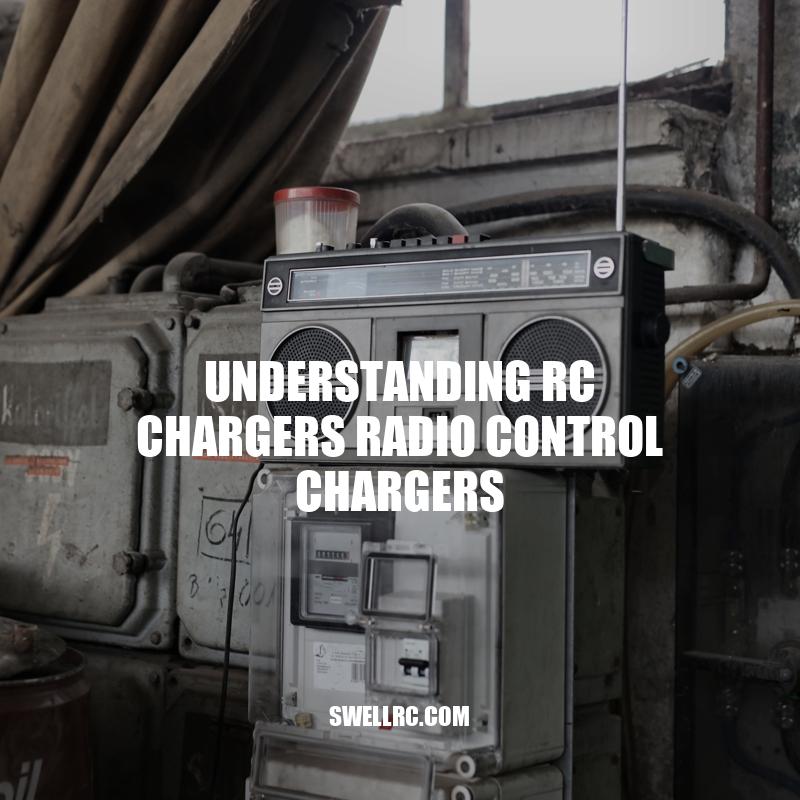Mastering RC Chargers: A Comprehensive Guide
Radio control (RC) is a popular hobby that involves the use of remote-controlled vehicles, boats, and drones. While these machines are run by powerful batteries, they must be charged before use, which requires an understanding of the RC chargers. RC Chargers are electronic devices designed to recharge rechargeable batteries like LiPo, LiFe, NiMH, and more. These chargers help preserve the lifespan of the batteries and ensure that they perform at peak levels when powering the RC vehicles. It’s important to choose the right type of charger for your batteries to avoid damaging them or affecting their performance. Understanding the basics of RC Chargers can be overwhelming for beginners, but it’s essential to get a grasp of what to look for in a battery charger. In this article, we’ll discuss everything you need to know about RC Chargers, including their types, features, charge rates, battery connections, and maintenance practices.
Features of RC Chargers
RC Chargers come with different features and capabilities that make them ideal for specific types of batteries. Some features to take into consideration when choosing an RC charger include:
- Voltage rating and capacity: the charger’s voltage rating should match or exceed the battery’s voltage rating, while its capacity should meet or exceed the battery’s capacity.
- Charge rate and current: the charger’s current rating should match or exceed the battery’s charge rate. Chargers can vary in amps and milliamps, and some offer different charge rates for different types of batteries.
- Safety features: it’s important to choose a charger that has safety features such as overcharge and short circuit protection to prevent damage to the battery and potential hazards.
Some reliable RC Chargers on the market are the Traxxas EZ-Peak Plus and SkyRC D100 v2. These chargers come with features like a high charging rate, multiple charge ports, and a sleek design. Many websites like RC Planet offer a variety of RC Chargers with detailed specifications and features.
How many different models of Chargers are there?
There are numerous models of chargers available in the market. Here are some of the most popular ones:
- Wall Chargers
- Car Chargers
- Portable Chargers or Power Banks
- Wireless Chargers
- Solar Chargers
To find the best charger that fits your device and charging needs, you can visit the websites of popular electronic brands like Apple, Samsung, and Anker. These websites offer a wide range of chargers, including their features and specifications.
Types of RC Chargers
There are different types of RC chargers available, with each type offering unique features to satisfy different charging needs. Some of the most common types are:
| Type of RC Charger | Description | Examples |
|---|---|---|
| AC Chargers | Connect to a wall socket and vary in charging capacity and charge rate. | ProTek RC AC/DC LiPo Charger, Tenergy TB6AC AC/DC Balance Charger |
| DC Chargers | Uses a car battery, yacht battery or portable power supply as the power source. | Turnigy Reaktor 250W 10A DC Balance Charger, Venom Pro Duo LiPo Charger |
| Single Port Chargers | Charges one battery at a time and often comes with built-in features for battery maintenance and diagnostics. | Maxxrace RC Balance Charger, Hitec RDX1 Mini AC Charger |
| Multi-port Chargers | Charges multiple batteries simultaneously and ideal for racers with multiple batteries. | Spektrum Smart S1200 DC Charger, E-flite Celectra 4-Port Charger |
| Balance Chargers | Uses extra pins on the charging port for balancing the voltage in each cell of a battery simultaneously. | iMax B6AC V2 Dual Power Balance Charger, SkyRC D100 v2 AC/DC Dual Balance Charger |
Choosing the right charger type minimizes charging time and prolongs the lifespan of batteries. Some popular websites such as Hobbyking, AMain Hobbies and Amazon offer reliable and affordable RC Chargers suitable for different types of batteries. Moreover, many hobby stores and manufacturers give recommendations on the best charger type to use for specific battery brands.
What Are the Different Types of Battery Chargers?
There are various types of battery chargers available in the market today. Some of the most common ones are:
- Trickle chargers
- Float chargers
- Fast chargers
- Pulse chargers
- Smart chargers
- Solar chargers
Trickle, float, and smart chargers are recommended for long-term battery maintenance, while fast and pulse chargers are more suitable for quick charging. Solar chargers, on the other hand, function with the help of solar panels, making them an Eco-friendly option.
If you’re looking for a reliable and affordable battery charger, some popular brands include NOCO, Battery Tender, and CTEK. Check out their websites for more information on their products.
Understanding Charge Rates
Charge rate is the amount of current that flows into a battery per hour during charging. Understanding charge rate gives insight on how to recharge batteries without damaging them prematurely. Here are some important factors to consider when charging an RC battery:
- C-Rating and discharge rates: Charging must be within the C-Rating specified by the manufacturer. Failure to comply could result in battery damage, swelling or even explosion.
- Maximum charge rate and capacity of batteries: It is best to charge at the maximum rate recommended to lessen the charging time, albeit not exceeding 1C rate for LiPo batteries.
- How charging affects battery lifespan: Batteries that discharge deeper become more sensitive to overheat during charging. Hence, fast charging batteries repeatedly shortens the lifespan of the battery.
To determine the charge rate and battery capacity of an RC battery, check the specs on the battery or use an online RC battery capacity calculator. Knowing the battery’s maximum charge rate keeps you in the safe zone.
Amazon, RC Planet, and Nitro Hobbies have a large collection of high-quality RC battery chargers that work seamlessly with all kinds of batteries. The chargers on these websites provide accurate charge rates for optimal performance and faster charging times, so you don’t have to worry about damaging your battery.
What is A Charge Rate?
A charge rate refers to the amount of current supplied to charge a battery or other energy storage device within a particular time frame. It is usually measured in amperes (A) and determines how fast a battery can be charged.
Some products, such as power banks, may have different charge rate options that can be selected depending on how quickly the user wants their device to charge. It is important to follow the manufacturer’s instructions for charging rates to avoid damaging the battery or device.
Battery Connection and Charging Methods
Different types of batteries require unique charging methods and connection types to charge effectively without damaging the battery. Here are the most common charging methods and connection types you need to know:
- Connection methods for LiPo, NiMH, and LiFe batteries: Proper connection of the battery to the charger is paramount for safe and effective charging. Different battery types and packs have different connectors and must be connected correctly to function correctly.
- Charging methods such as balance charge, fast charge, and storage charge: Battery balancing helps increase battery performance and longevity, while fast charging is used when time is limited. Storage charging prevents LiPo batteries from swelling when stored.
- Understanding battery capacity calculation: RC batteries have different capacities, and understanding the capacity of your battery is essential to prevent overcharging, shortening battery life.
It is recommendable to refer to the manual that comes with the charger or the manufacturer’s website to ensure the right operation and charging applications of your batteries.
Websites like HobbyKing, Tower Hobbies, and AMain Hobbies offer compatible battery connection types and charging modes that are suitable for almost all kinds of RC batteries. These websites also have a vast assortment of RC batteries at affordable prices without compromising quality.
What are different methods of battery charging?
There are several ways to charge a battery, including:
- Constant voltage charging
- Fast charging
- Trickle charging
- Inductive charging
- Solar Charging
Each method has its own advantages and disadvantages depending on the type of battery being charged and the application. For more information on battery charging methods, consult reliable sources online such as battery manufacturers’ websites or battery review websites like Battery University.
Maintaining RC Chargers
To ensure that your RC charger performs efficiently and has a longer lifespan, proper care and maintenance must be carried out. Below are some of the best practices for maintaining your RC chargers:
- Best practices for maintaining and storing chargers: Always store the charger in a cool, dry place, especially the AC charger, and avoid direct sunlight, which could cause stress to the internal parts. Do not expose the charger to moisture, and keep a clear distance from water.
- Checking for damages and wear and tear: Regularly inspect your charger for any damage or faults that might impair its functionality such as loose AC or DC ports, damaged cords, or dust accumulation
- Proper cleaning and safety precautions: Clean your charger with a soft cloth regularly, and use a mild detergent for stubborn dirt. Always take necessary safety precautions, such as putting on protective gear like gloves and goggles, if you need to disassemble the charger.
It is vital to note that some chargers may have different maintenance requirements, so always refer to the manufacturer’s manual for detailed instructions.
Websites like Amazon, Motion RC or Horizon Hobby offer a wide array of charger brands, with different capabilities and accessories, that have excellent reviews from users. They also provide various customer-oriented services, such as 24/7 customer support, exchange and refund policies, and free shipping or delivery.
How do you maintain a charger?
To ensure your charger lasts as long as it can, you should take some steps to maintain it. Here are some tips:
- Store your charger in a dry place.
- Avoid extreme temperatures as it can damage the battery.
- Unplug your charger after it’s done charging.
- Avoid yanking the cord when unplugging it, instead pull it from the base of the plug.
- Clean the charger with a dry or slightly damp cloth regularly.
Note that each charger might require different maintenance. Check the product manual or the manufacturer’s website for specific instructions.
Conclusion
Understanding RC chargers and their functions is fundamental for every RC hobbyist and enthusiast who wants to ensure that their RC batteries perform optimally, last longer and are safe to use. With this guide, we hope to give our readers a better insight into the types, features, and maintenance of RC chargers. Make sure you choose the charger that suits your batteries’ requirements, regularly check for any malfunctions or wear and tear, and follow the charger’s instructions for safe usage.
Having adequate knowledge of how to operate, use, and maintain your RC chargers guarantees that your batteries and models will last long and remain in the best condition. Technologies, features, and trends with RC chargers continually evolve with new charger models being regularly introduced into the market. As such, it is always best to keep updated with the latest information, technologies, and innovations regarding RC chargers.
By following the tips in this article, you are now one step closer to having a better understanding of RC chargers for your hobby. Always remember to seek guidance from experts or experienced hobbyists to ensure you make the best choices and investments in your RC hobby.



